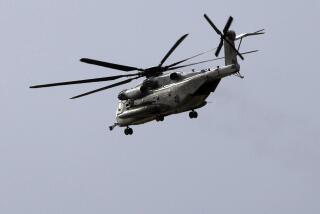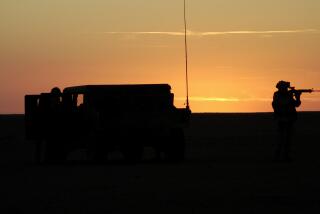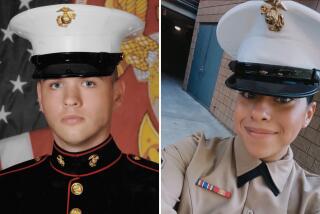Marines defend actions in Afghan deaths
CAMP LEJEUNE, N.C. — Three Marines and an Afghan translator testified Wednesday that their convoy came under fire in Afghanistan after a car bomb attack in March, prompting return fire as the Marines tried to escape what they called the “kill zone.” As many as 19 Afghans were reported killed.
The testimony came on the second day of a court of inquiry examining the incident. The Afghanistan Independent Human Rights Commission has accused the Marine Special Operations members of firing indiscriminately, killing civilian men, women and children.
Those who testified said they did not see gunmen or feel bullets strike their vehicles. But the Marines said they feared for their lives and fired back in accordance with military rules of engagement.
“I’m sure we had to kill some guys who were shooting at us, sir,” said Sgt. Brett Hayes, who was in the second of six vehicles in the convoy outside Jalalabad in eastern Afghanistan.
The testimony contradicted statements made to the court Tuesday by a counterintelligence sergeant on the convoy, who described dead Afghan civilians and what he called “excessive” Marine fire.
The inquiry is a fact-finding body, not a criminal court. The tribunal’s three Marine officers are investigating the actions of the unit and two of its commanders, Maj. Fred C. Galvin and Capt. Vincent J. Noble. The panel will report its findings to the commanding general of the Special Operations Command, who will decide whether to take action. No one has been charged in the March 4 incident.
An Army investigation concluded that 19 Afghan civilians died and 50 were wounded. Defense lawyers contend that the numbers are lower.
Testimony Wednesday focused on whether the Marines perceived that they were under enemy fire, rather than whom or what they shot.
Lawyers for Galvin and Noble elicited testimony that Marine gunners fired for a much shorter period of time and over a shorter distance than described in the human rights report. That report said the Marines fired for an extended period over 10 miles of highway.
Ask to describe the car bombing that preceded the Marines’ gunfire, Hayes replied: “I thought I was dead. I thought there was no way I’d make it through this.”
Another Marine, Sgt. Joshua Henderson, was slightly wounded in the attack. He was knocked from the turret by the explosion, Hayes said, but got back up on his M240 machine gun and began firing.
Hayes said he felt threatened by vehicles that continued to drive toward the convoy. He and the other two Marines said Henderson and another turret gunner, Sgt. Peter Brooks, adhered to “escalation of force” rules by first shooting warning shots into the pavement and then into vehicles’ engine blocks.
The interpreter, Habib Abdul Sahar, an Afghan with U.S. citizenship who was in the third vehicle, said Noble yelled, “We’re in contact!” after the blast and told his men they needed to escape the “kill zone.” Sahar said he heard what sounded like small-arms fire “from a distance.”
“It sounded like Kalashnikovs . . . single shots, like dat, dat dat,” he said.
Asked whether he thought the Marines’ response was “strange” or in any way improper, Sahar replied, “No, sir.”
Although the counterintelligence sergeant testified Tuesday that Sahar was upset by the deaths of civilians, Sahar said he considered media accounts of 19 dead civilians a “false report.”
Sgt. Jason Roberts, who drove the lead vehicle, said he believed “snaps and pops” he heard just after the car bomb exploded were enemy small-arms fire.
Sgt. Benjamin Baker, who was in the front seat of the lead vehicle, said he believed the convoy was under fire after he saw the vehicle’s gunner, Brooks, fire his machine gun. After the convoy left the bomb site and began driving back to its base in Jalalabad, Baker said he saw small tree branches drop onto the roadway -- downed by automatic weapons fire.
Hayes said Henderson emptied the ammunition in his 200-round magazine. He said that Henderson continued to fire after he supplied him with a new magazine and that he heard Henderson yell, “Contact left!” and “Contact right!” -- meaning the gunner believed fire was coming from both sides of the highway.
Hayes and others who testified said the gunners hit a black truck driving toward them on the highway, which they feared was a second suicide vehicle bomb. They were not asked whether the gunners hit anything else.
Asked about reports that Afghans had died during the incident, Hayes replied: “The ones who were shooting at us, sir.”
Roberts said the convoy stopped firing after the incoming fire ceased, except for warning shots fired in the air to disperse a crowd on the highway.
Marine Special Operations Company F was the first Marine Special Operations unit to deploy in combat. The 120-man company had been in Afghanistan less than a month before the incident. It was ordered out of the country shortly afterward.
Lawyers for Galvin, the company commander, and Noble, commander of the convoy platoon, pressed the Marines for their impressions of the officers’ leadership and performance under fire.
“I’d follow both these men to the end of the world,” Baker said.
--
More to Read
Sign up for Essential California
The most important California stories and recommendations in your inbox every morning.
You may occasionally receive promotional content from the Los Angeles Times.











